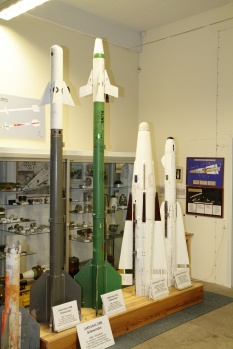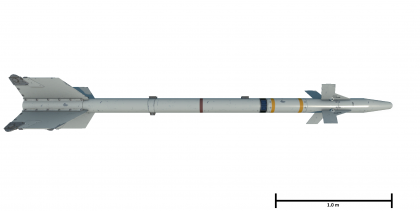Difference between revisions of "AIM-9P Sidewinder"
(→Pros and cons) (Tag: Visual edit) |
U109038889 (talk | contribs) (elaborated on the "usage in battles" segment) (Tag: Visual edit) |
||
| (4 intermediate revisions by 4 users not shown) | |||
| Line 21: | Line 21: | ||
{{Navigation-First-Line|'''AIM-9P Sidewinder'''}} | {{Navigation-First-Line|'''AIM-9P Sidewinder'''}} | ||
{{Navigation-Line|A-5}}{{Specs-Link|a_5c}} | {{Navigation-Line|A-5}}{{Specs-Link|a_5c}} | ||
| − | {{Navigation-Line|T-2}}{{Specs-Link|t2}} | + | {{Navigation-Line|T-2}}{{Specs-Link|t2_early}}{{-}}{{Specs-Link|t2}} |
{{Navigation-Line|F-1}}{{Specs-Link|f1}} | {{Navigation-Line|F-1}}{{Specs-Link|f1}} | ||
{{Navigation-Line|F-4}}{{Specs-Link|f-4ej}}{{-}}{{Specs-Link|f-4ej_adtw}}{{-}}{{Specs-Link|f-4ej_kai}} | {{Navigation-Line|F-4}}{{Specs-Link|f-4ej}}{{-}}{{Specs-Link|f-4ej_adtw}}{{-}}{{Specs-Link|f-4ej_kai}} | ||
{{Navigation-Line|F-5}}{{Specs-Link|f-5a_china}}{{-}}{{Specs-Link|f-5e_aidc}} | {{Navigation-Line|F-5}}{{Specs-Link|f-5a_china}}{{-}}{{Specs-Link|f-5e_aidc}} | ||
| − | {{Navigation-Line|F- | + | {{Navigation-Line|F-14}}{{Specs-Link|f_14a_iriaf}} |
| + | {{Navigation-Line|F-16}}{{Specs-Link|f_16aj}}{{-}}{{Specs-Link|f_16a_block_20_mlu}}{{-}}{{Specs-Link|f_16a_block_10_iaf}}{{-}}{{Specs-Link|f_16d_block_40_barak_2}} | ||
{{Navigation-Line|F-104}}{{Specs-Link|f-104j}}{{-}}{{Specs-Link|f-104s_cb}} | {{Navigation-Line|F-104}}{{Specs-Link|f-104j}}{{-}}{{Specs-Link|f-104s_cb}} | ||
| Line 67: | Line 68: | ||
<!-- ''Give a comparative description of missiles that have firepower equal to this weapon.'' --> | <!-- ''Give a comparative description of missiles that have firepower equal to this weapon.'' --> | ||
The AIM-9P is an export version of the US AIM-9J sold to China mostly. The AIM-9P has the same performance as the AIM-9J used in the American tech tree. Except with the addition of radar slaving. | The AIM-9P is an export version of the US AIM-9J sold to China mostly. The AIM-9P has the same performance as the AIM-9J used in the American tech tree. Except with the addition of radar slaving. | ||
| + | |||
| + | {{AIM-9 Comparison Table}} | ||
== Usage in battles == | == Usage in battles == | ||
<!--''Describe situations when you would utilise this missile in-game (vehicle, pillbox, base, etc)''--> | <!--''Describe situations when you would utilise this missile in-game (vehicle, pillbox, base, etc)''--> | ||
| − | The AIM-9P Sidewinder can be used in battle as an air-to-air missile. You | + | The AIM-9P Sidewinder can be used in battle as an air-to-air missile. The missle is most effective during top down attack at ~2.1 km (1.3 miles) or ~1.9 km (1.18 miles) on direct rear aspect shots. It is heavily affected by altitude, being able to launch nearly straight up, at around 2.6 km and still have enough energy to hit enemy aircraft. You may have to fire the missle a bit closer when engaging fast aircraft such as the MiG-23 or the F-104. |
=== Pros and cons === | === Pros and cons === | ||
Latest revision as of 13:12, 25 November 2024
| This page is about the American air-to-air missile AIM-9P Sidewinder. For other versions, see AIM-9 Sidewinder (Family). |
Contents
Description
The AIM-9P Sidewinder is an American infrared homing air-to-air missile, it was introduced in Update "New Power".
As an export version of the AIM-9 Sidewinder, the AIM-9P delivers performance akin to that of the AIM-9J that allows for the AIM-9P to be used as a dogfighting missile against low-manoeuvring aircraft.
The AIM-9P-3 was designated as the RB24J in Swedish service, and as the Flz Lwf 63/80 in Swiss service.
Vehicles equipped with this weapon
| Vehicles equipped with this weapon | |
|---|---|
| AIM-9P Sidewinder | |
| A-5 | A-5C |
| T-2 | T-2 Early · T-2 |
| F-1 | F-1 |
| F-4 | F-4EJ Phantom II · F-4EJ ADTW · F-4EJ Kai Phantom II |
| F-5 | ␗F-5A · ␗F-5E |
| F-14 | ▄F-14A IRIAF |
| F-16 | F-16AJ · ␗F-16A MLU · Netz · F-16D Barak II |
| F-104 | F-104J · ▄F-104S TAF |
| RB24J | |
| SAAB 35 | J35D · Saab J35XS |
| SAAB 37 | JA37C · JA37D · AJ37 · AJS37 |
| Flz Lwf 63/80 | ◌Hunter F.58 |
General info
| Missile characteristics | |
|---|---|
| Mass | 76.93 kg |
| Guidance | IR |
| Aspect | Rear-aspect |
| Lock range (rear-aspect) | 5.5 km |
| Launch range | 18 km |
| Maximum speed | 2.5 M |
| Maximum overload | 20 G |
| Missile guidance time | 40 secs |
| Explosive mass | 7.62 kg TNTeq |
Effective damage
Describe the type of damage produced by this type of missile (high explosive, splash damage, etc)
Comparison with analogues
The AIM-9P is an export version of the US AIM-9J sold to China mostly. The AIM-9P has the same performance as the AIM-9J used in the American tech tree. Except with the addition of radar slaving.
- AIM-9B FGW.2 Sidewinder - A European-licensed version of the AIM-9B with their own improvements; however the performance in-game are quite similar.
- R-3S/PL-2 - Infamous as a reverse-engineered variant of the AIM-9B, the R-3 missile shares many of its in-game performances with the AIM-9B, only falling slightly short in locking and launching range.
- Shafrir - Shares in-game performance values despite their design differences
- Rb24 - Licensed-produced version of the AIM-9B for the Swedish, and as such shares in-game performance values.
| Missile | Guidance | Lock range (rear-aspect)(km) |
Launch range (km) |
Maximum speed (Mach) |
Maximum overload (g) |
Mass (kg) |
TNT Equivalent (kg) | |||||
|---|---|---|---|---|---|---|---|---|---|---|---|---|
| Type | Aspect | Time | Uncaged seeker | Radar slaving | ||||||||
| |
AIM-9B Sidewinder | IR | Rear | 20 | |
|
4 | 10 | 1.7 | 10 | 72 | 7.62 |
| |
AIM-9C Sidewinder | SARH | Front | 60 | |
|
9 | 18 | 2.5 | 18 | 95 | 4.69 |
| |
AIM-9D Sidewinder[note 1] | IR | Rear | 20 | |
|
5.5 | 18 | 2.5 | 18 | 88 | 4.69 |
| |
AIM-9E Sidewinder[note 2] | IR | Rear | 20 | |
|
5.5 | 18 | 2.8 | 10 | 76 | 7.62 |
| |
AIM-9G Sidewinder | IR | Rear | 60 | |
|
5.5 | 18 | 2.5 | 18 | 88 | 3.53 |
| |
AIM-9H Sidewinder | IR | Rear | 60 | |
|
5.5 | 18 | 2.5 | 18 | 88 | 3.53 |
| |
AIM-9J Sidewinder[note 3] | IR | Rear | 40 | |
|
5.5 | 18 | 2.5 | 20 | 76 | 7.62 |
| |
AIM-9L Sidewinder | IR | All | 60 | |
|
11 | 18 | 2.5 | 30 | 84 | 4.58 |
| |
AIM-9M Sidewinder | IR | All | 60 | |
|
11 | 18 | 2.5 | 30 | 84 | 4.58 |
| |
AIM-9P Sidewinder | IR | Rear | 40 | |
|
5.5 | 18 | 2.5 | 20 | 76.93 | 7.62 |
| |
AIM-9P4 Sidewinder | IR | All | 40 | |
|
11 | 18 | 2.5 | 20 | 76.93 | 7.62 |
| |
AIM-9B FGW.2 Sidewinder | IR | Rear | 20 | |
|
5.5 | 10 | 1.7 | 10 | 72 | 7.62 |
| |
Shafrir | IR | Rear | 20 | |
|
7 | 10 | 1.7 | 11 | 65 | 7.62 |
| |
RB24 | IR | Rear | 20 | |
|
4 | 10 | 1.7 | 10 | 72 | 7.62 |
| |
R-3S | IR | Rear | 21 | |
|
9 | 10 | 1.7 | 10 | 75 | 8.8 |
| |
PL-2 | IR | Rear | 21 | |
|
9 | 10 | 1.7 | 10 | 75 | 8.8 |
Usage in battles
The AIM-9P Sidewinder can be used in battle as an air-to-air missile. The missle is most effective during top down attack at ~2.1 km (1.3 miles) or ~1.9 km (1.18 miles) on direct rear aspect shots. It is heavily affected by altitude, being able to launch nearly straight up, at around 2.6 km and still have enough energy to hit enemy aircraft. You may have to fire the missle a bit closer when engaging fast aircraft such as the MiG-23 or the F-104.
Pros and cons
Pros:
- 20G maximum overload
- Simple point-lock-shoot user usage
- Good seeker FOV
Cons:
- Limited range
History
When the AIM-9L Sidewinder began to be put into production in 1976 to replace other Sidewinder variants as the United States' main IR missile,[1] a need was created for Sidewinders to offer to the United States' allies that did not need or were not allowed access to the newest AIM-9 Sidewinder variants and their associated features such as all-aspect locking.[2]
The AIM-9P Sidewinder missile was developed as a family of export missiles. Sponsored by the US Air Force, this variant was based off the AIM-9J/N variants, though would be updated multiple times incorporating new features and improvements.[2][3]

- Variants of the AIM-9P
- AIM-9P - The first version, which is an improved AIM-9J model with greater engagement ranges. It also incorporates solid-state technology for better reliability and maintainability. Deliveries of this missile started in 1978.[4]
- AIM-9P-1 - Introduces an active optical target detector with the DSU-15/B AOTD laser proximity fuze, replacing the old infrared influence fuze.[2][4]
- AIM-9P-2 - Introduces a reduced-smoke rocket motor.[2][4]
- AIM-9P-3 - Alongside the reduced-smoke rocket motor like the preceding P-2, the P-3 also includes a new insensitive munitions warhead and improved guidance and control section. Fuzing appears to be a mix of the original infrared fuze or the active optical target detector as the P-1.[2][4] The AIM-9P-3 is also the basis of the Swedish RB24J missile.[5]
- AIM-9P-4 - Introduces ALASCA features and technology of the AIM-9L variants.[2] However, it is considered less agile to the AIM-9L variant.[3]
- AIM-9P-5 - Introduces IRCCM incorporated in the AIM-9M variant.[2] This model is also the basis of the Swedish RB74, or RB24L, missile.[5]
More than 21,000 AIM-9P models were built during its production, though many were rebuilt AIM-9B/E/J. Despite being slated for export use, most of the missiles are in US Air Force inventory.[2]
Media
Excellent additions to the article would be video guides, screenshots from the game, and photos.
See also
- Related development
External links
References
- Citations
- Bibliography
- GlobalSecurity.org "AIM-9 Sidewinder." GlobalSecurity.org, Website. Accessed 02 Apr 2021 (Archive).
- Goebel, Greg. "The Falcon & Sidewinder Air-To-Air Missiles." Air Vectors, 01 Mar. 2021, Website. Accessed 02 Apr 2021 (Archive).
- Kopp, Carlo. "The Sidewinder Story: The Evolution of the AIM-9 Missile." Air Power Australia, 27 Jan 2014, Website. Accessed 02 Apr 2021 (Archive).
- Parsch, Andreas. "AIM-9." Directory of U.S. Military Rockets and Missiles, Designation-Systems.Net, 09 July 2008, Website. Accessed 02 Apr 2021 (Archive).
- Westrum, Ron. Sidewinder; Creative Missile Development at China Lake. Naval Institute Press, 30 Sep. 2013.




